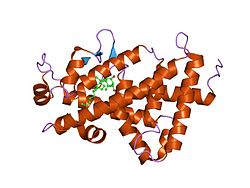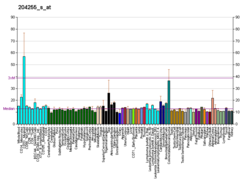The vitamin D receptor (VDR also known as the calcitriol receptor) is a member of the nuclear receptor family of transcription factors. [5] Calcitriol (the active form of vitamin D, 1,25-(OH)2vitamin D3) binds to VDR, which then forms a heterodimer with the retinoid-X receptor. The VDR heterodimer then enters the nucleus and binds to Vitamin D responsive elements (VDRE) in genomic DNA. VDR binding results in expression or transrepression of many specific gene products. VDR is also involved in microRNA-directed post transcriptional mechanisms. [6] In humans, the vitamin D receptor is encoded by the VDR gene located on chromosome 12q13.11. [7]
VDR is expressed in most tissues of the body, and regulates transcription of genes involved in intestinal and renal transport of calcium and other minerals. [8] Glucocorticoids decrease VDR expression. [8] Many types of immune cells also express VDR. [9]






















